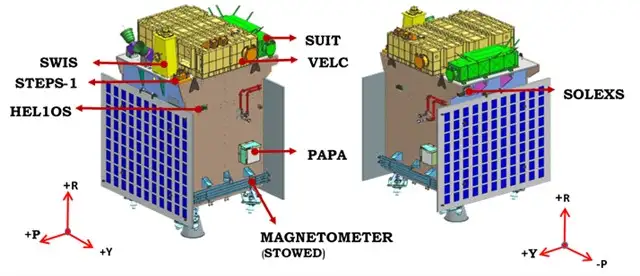Report by Drishti Baheti
After a successful mission to the moon with Chandrayan 3, the Indian Space Research Organization has a mission planned to the closest star – the sun.
The Aditya-L1 mission seeks to deepen our understanding of our closest star, the sun.
Named after the Indian solar deity – Aditya, this mission will investigate solar activity, Heliophysics, and their implications for Earth and beyond.
This mission will take 4 months to reach its location – Lagrange point-1 or L1.

What is L1?
L1 is the Lagrange point 1.
L1 is located 1.5 million kilometres away from Earth.
Lagrange points are positions in space where objects sent there tend to stay put. At Lagrange points, the gravitational pull of two large masses precisely equals the centripetal force required for a small object to move with them. These points in space can be used by spacecraft to reduce fuel consumption needed to remain in position. There are 5 Lagrange points between the orbit of sun-earth. 3 of them are unstable while the other 2 are stable.

The primary objective of the Aditya-L1 mission is to observe the sun’s outermost layer, known as the corona, and study its dynamics, variations, and processes. The corona plays a pivotal role in space weather phenomena, including solar flares and coronal mass ejections, which can have substantial impact on Earth’s technological infrastructure such as satellite communications and power grids.
What will the mission do?
This mission aims to:
Study the Corona
The corona’s extreme temperatures and high-energy phenomena have puzzled scientists for decades. Aditya-L1 will endeavour to gather comprehensive data on the corona to help unravel the mysteries surrounding its behaviour.
Understand Solar Winds
The mission will investigate the solar wind, a stream of charged particles from the sun. Understanding the composition and speed of solar wind will contribute to our knowledge of space weather and its effects on Earth’s magnetosphere.
Predict Space Weather
By analyzing the data collected from Aditya-L1, scientists hope to enhance their ability to predict space weather events, which can impact satellite operations, aviation, and power distribution on Earth.
Helioseismology
The mission will also engage in helioseismology, the study of solar vibrations, to gain insights into the sun’s internal structure and processes.
What is Helioseismology?
Helioseismology is the study of the structure and dynamics of the Sun through its oscillations (oscillation is going back and forth repeatedly between two positions). These are principally caused by sound waves continuously driven and damped by convection near the Sun’s surface.
The Technological Aspects
The Aditya-L1 spacecraft will be equipped with the most advanced instruments to capture various aspects of solar activity:
Visible Emission Line Coronagraph (VELC)
VELC will provide high-resolution images of the corona, helping scientists study its dynamics and magnetic structures.
Aditya Solar Wind Particle Experiment (ASPEX)
ASPEX will measure the solar wind’s properties and help us understand its influence on Earth’s magnetosphere.
Plasma Analyzer Package for Aditya (PAPA)
PAPA will analyze the composition and variations in the solar wind.
Solar Ultraviolet Imaging Telescope (SUIT)
SUIT will capture images of the sun’s ultraviolet emissions, helping in the study of the corona’s temperature and dynamics.
The Significance and Potential Benefits of the Mission
Space Weather Prediction – Improved space weather prediction can safeguard satellites, astronauts, and technology from the adverse effects of solar activity.
Technological Resilience – Insights gained from the mission could guide the development of more resilient technology and infrastructure to withstand space weather events.
Fundamental Science – The mission will contribute to our understanding of fundamental solar and astrophysical processes, enriching our knowledge of the universe.
International Collaboration – Aditya-L1 provides opportunities for international collaboration in space research and exploration, fostering knowledge, exchange, and co-operation.
The Aditya-L1 craft will be launched on 2nd September 2023 from the Satish Dhawan Space Centre, Srihari Kota, India.
You can be there!
ISRO has invited all Indians to register and be there at the viewing gallery on the day of the launch.
You can register to attend the launch here.
There is NO Charge for attending the launch.


One Reply to “Aditya-L1: India’s first mission to the Sun”
Comments are closed.